The little town of Etretat is located in the Pays de Caux, on a section of the Normandy coast called “La Côte d’Albâtre” (Alabaster Coast). It is renowned for its impressive white cliffs, which feature arches, a large rock needle, and tunnels.
Etretat, a harbour in Normandy
“If I had to show the sea to a friend for the first time, I would choose to go to Etretat”
French novelist Alphonse Karr (1808-1890)
Etretat is one of many stops of interest on the 130 km coastal road along the Côte d’Albâtre, which runs from Le Tréport to Le Havre.

The resemblance with the opposite coast in England is striking, for the English and French coasts share the same common feature: high chalk cliffs.
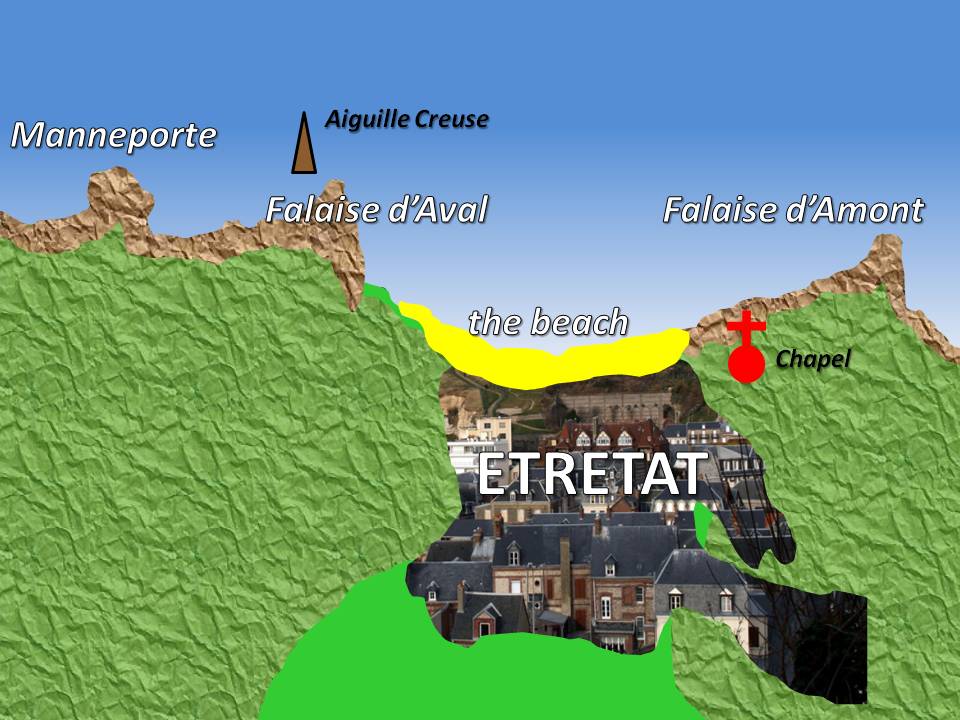
Accommodation in Étretat
Finding a place to stay in Étretat is a delightful experience, with options ranging from charming bed and breakfasts to luxurious hotels.
Many accommodations offer stunning views of the iconic cliffs and easy access to the beach.
Whether you’re looking for a cosy room in a traditional Norman house or a modern suite with all the amenities, you’ll find something to suit your needs.
For the best selection and deals, click here to book your stay (affiliate link).
This platform provides a variety of choices, ensuring you find the perfect accommodation for your visit to this picturesque coastal town.
You can also browse the map below to find more accommodation options:
Étretat, a bit of history
An old legend says that the village was founded following a Viking invasion.
The Legend of Étretat’s Founding
According to an old legend, the founding of the village of Étretat is attributed to the Vikings.
These seafarers, arriving on their esnèque (longship), allegedly attempted to assault a lady named Olive, a wealthy and devout woman.
She was accustomed to bathing or washing her clothes at a fountain located at the base of a rock.
The name “Fontaine Olive” has endured. It now refers to a spring that has become submerged due to the coastline’s retreat, marked by an ancient square enclosure on the beach.
During the Merovingian period
In the presbytery’s garden lies another cemetery, covering Roman-era ruins. Dating back to the Merovingian period, it includes the graves of soldiers typical for the region.
Among the finds are a spatha (a type of sword), bronze clasps, belt buckles, and a scramasaxe (a single-edged blade). These relics offer a fascinating glimpse into the area’s ancient past.
In the Middle Ages
In the 10th century, Étretat was under the rule of the Dukes of Normandy.
It later came under the authority of the Abbey of Fécamp, which established hermitages outside the village, including a church in the 12th century and several farms.
Unlike Fécamp, Étretat provided ships for King Philip of Valois of France. Due to the Anglo-French rivalry, the port was either abandoned or given to the seigneury of Bénouville.
On 15 January 1525, the fishing village was submerged.
The Shift from Fishing to Tourism
Étretat transitioned from a small fishing village to a popular seaside resort during a pivotal period.
Over time, fishing was replaced by tourism as the main activity.
Despite recurring plans from Francis I to Napoleon I to construct a military port, the project was abandoned.
Various French kings attempted to protect Le Havre through different schemes, including Admiral Bonivel’s for Francis I, another for Colbert, one for Louis XVI, and finally, Lapeyre’s plan for Napoleon I, preserved in the Archives of Seine-Maritime.
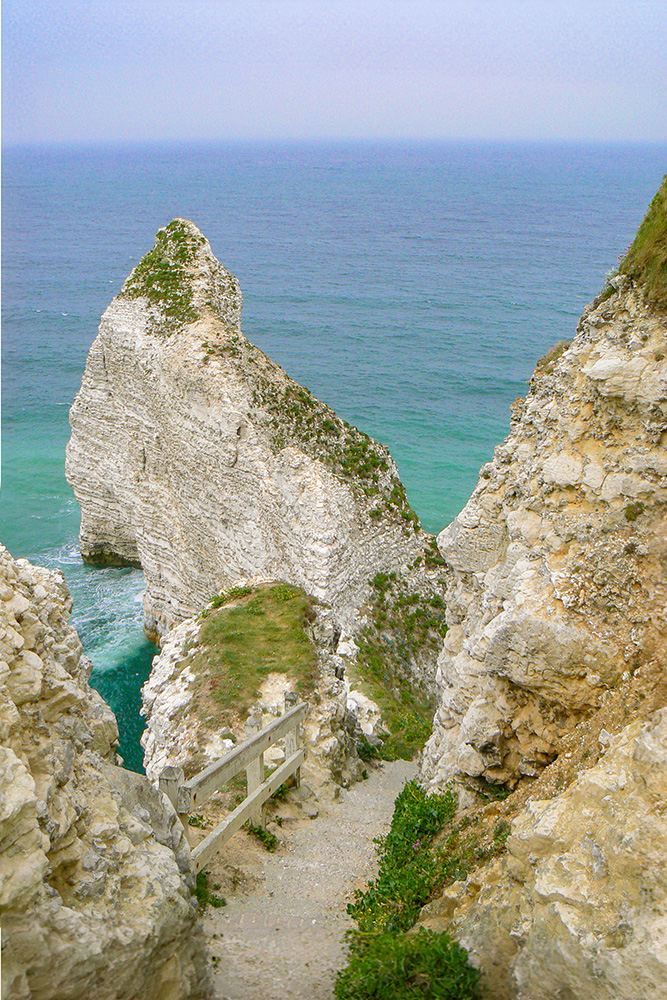
The 18th Century Developments
In 1761, Jean Huber described Étretat as “a beautiful little town near the sea, a short distance from Cape Antifer.”
The town’s two oldest buildings date from this era.
In the 18th century, Étretat cultivated and refined oysters for Marie-Antoinette, with fresh oysters delivered overnight to Versailles.
Today, remnants of the oyster beds are visible at the base of the Aval cliff.
In 1777, to please the Queen, the Marquis de Belvert transported oysters by two sloops, “La Syrène” and “La Cauchoise,” from Cancale Bay.
He refined them in a mix of seawater and freshwater before shipping them to Paris by donkey or horse.
The Decline of Fishing
During the first half of the century, there were about twenty-five to thirty fishing boats on the Perrey.
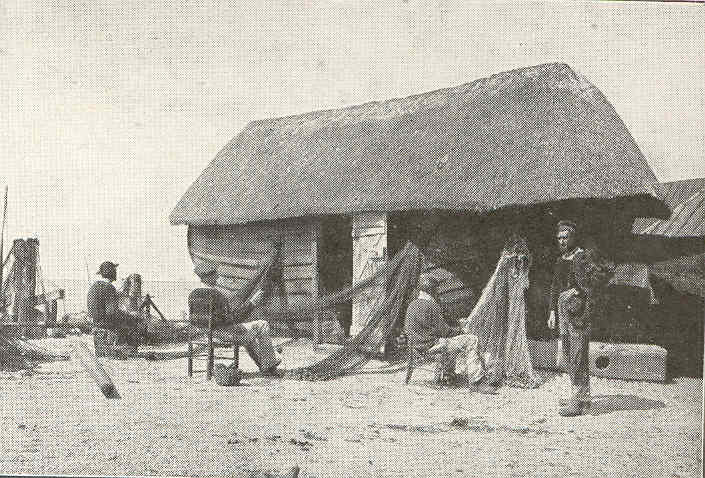
However, by 1850, their numbers had dwindled to just one. These were replaced by coastal fishing boats.
Traditional clinker-built boats sailed to Dieppe in late autumn to fish for herring, with the village housing 250 to 300 sailors.
Mackerel fishing during the summer remained the only thriving activity until the late 19th century.
Artistic Discovery
The site was discovered by Eugène Isabey in 1820, who spent six months painting there.
He introduced the location to his friends and romantic painters like Bonington, Paul Huet, and Roqueplan, who depicted the dramatic storms, shipwrecks, and sheer cliffs.
In 1831, Eugène Lepoittevin built a studio to study the sea.
By 1840, John Murray’s travel guide described Étretat to English tourists, recommending it as a stop on the route from Le Havre to Dieppe, highlighting the village’s picturesque arches, needles, and other fantastic rock formations.
Rise of Seaside Resorts
In 1824, Dieppe established a bathing facility, popularised by the Duchess of Berry.
This led to the high society of Paris frequenting seaside resorts and adopting neo-Norman architecture along the Alabaster Coast.
Yet, the village of 300 impoverished fishermen did not immediately benefit from this trend.
It was repeatedly destroyed by storms and high tides in 1806, 1807, 1808, 1823, and 1842, causing numerous deaths despite attempts to install a small canal with a lock.
![Etretat - By Jörg Braukmann — licence [CC BY-SA 4.0] from Wikimedia Commons](https://frenchmoments.eu/wp-content/uploads/2012/11/Etretat-By-Jorg-Braukmann-—-licence-CC-BY-SA-4.0-from-Wikimedia-Commons.jpg)
The Popularity Boom Post-1843
Étretat only succumbed to the seaside resort fashion after 1843.
Alphonse Karr’s 1836 novel “Histoire de Romain d’Étretat” significantly contributed to the town’s popularity.
Roads to Fécamp and Le Havre were constructed, and regular horse-drawn omnibus services were established.
During Napoleon III’s era, a project to develop a seaside resort was initiated by the Duke of Morny, Count d’Escherny, and Lecomte-du Nouÿ, attracting investors from the Paris Opera.
Villas in a seaside style began to be built rapidly, with the village and villas constructed from cut flint and bricks.
In 1852, a casino of planks and slates opened under the newly formed Société des Bains de mer d’Étretat. It hosted performances like Jacques Offenbach’s “Orpheus in the Underworld.”
The Artistic and Social Hub
Notable figures from the Paris Opera built villas in Étretat, commissioning paintings of the cliffs.
By 1861, Murray’s travel guide described the railway station of Ifs-Étretat, where cabs served a well-suited seaside resort “remarkable for its coastal beauty.”
The Parisian society took the “pleasure train” from Saint-Lazare station to Le Havre for the 1869 universal exhibition, with Courbet and Alexandre Dumas praising Étretat’s picturesque scenery.
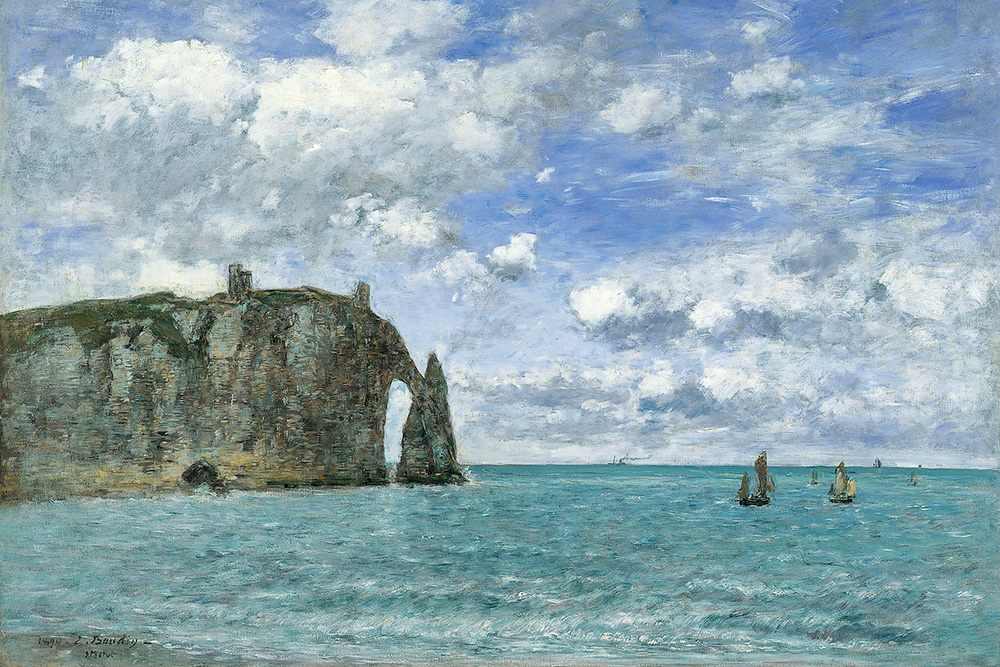
However, the challenging location between cliffs and the lack of sand made it less popular than beaches like Trouville-sur-Mer, Dieppe, or Le Havre.
The main issue was the poor quality of the access roads.
Étretat During the Franco-Prussian War
In December 1870, Prussian Uhlans easily captured the town, seemingly disappointed by the renowned Second Empire resort.
Transformation and Tourism
In the 19th century, Étretat underwent significant changes.
The small river running through the Grand Val was buried, turning into an underground river that now flows directly into the sea, visible at low tide.
The town expanded onto the Perrey, preventing the sea from flooding the valley at high tide.
With the fame of its cliffs, popularised by the paintings of Claude Monet and Gustave Courbet, Étretat became an international tourist destination.
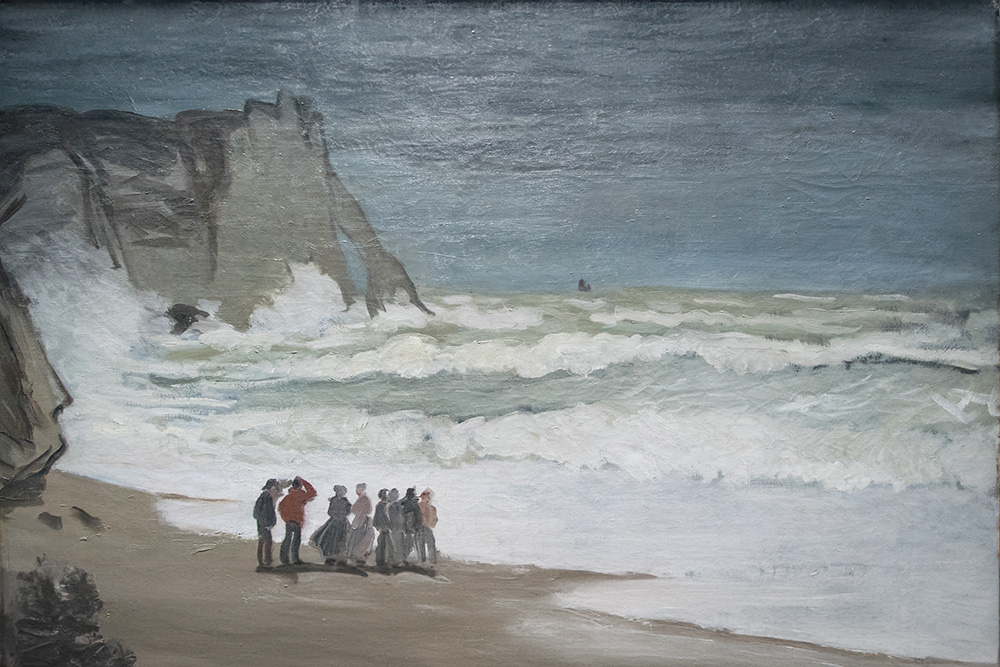
Its proximity to Paris, Le Havre, and Rouen, aided by modern transport, contributed to its success. The establishment of a railway line and station in 1895 further boosted accessibility and development.
Royal Visits and New Architecture
Queens of Spain, Maria Christina of Bourbon and her daughter Isabella II, regularly stayed until 1880 at the residence of Prince Lubomirski, the Tsar’s Grand Chamberlain.
In 1883, the Protestant Temple of Étretat was inaugurated. Designed by Émile Bénard and Charles Letrosne, it features the characteristic brick and flint architecture of the Pays de Caux.
The 20th Century: Urban Transformation
Though the natural site of Étretat remained unchanged, the town’s layout and atmosphere underwent significant changes in the 20th century.
Under the guidance of Émile Mauge, the city architect of Fécamp, Étretat saw the construction of half-timbered buildings in the Norman style, such as the Manor of the Salamander, the Market Halls, Clos Lupin, Orfraie, Villa Arthus, and the now-destroyed seaside casino.
![Houses in Etretat - By Dinkum — licence [CC0] from Wikimedia Commons](https://frenchmoments.eu/wp-content/uploads/2012/11/Houses-in-Etrerat-By-Dinkum-—-licence-CC0-from-Wikimedia-Commons.jpg)
World Wars Impact
During World War I, Étretat served as a rear base and the General Hospital No. 1 for the British and Commonwealth armies, later becoming the No. 2 Base Hospital Unit for the American army.
This history is commemorated by 564 graves in the British and American cemetery, a plaque in the market hall, and a granite bench on the perrey.
In 1922, the Friends of Étretat association was founded to support the town’s electrification.
Many Parisians had secondary residences in this fishing village.
World War II halted the growth of tourism.
![German bunker in Étretat - By Avi1111 dr. avishai teicher — licence [CC BY-SA 4.0] from Wikimedia Commons](https://frenchmoments.eu/wp-content/uploads/2012/11/German-bunker-in-Etretat-By-Avi1111-dr.-avishai-teicher-—-licence-CC-BY-SA-4.0-from-Wikimedia-Commons.jpg)
The German occupiers mutilated the seafront, destroying the casino and villas to fortify the site against a potential Allied landing.
Villas were occupied and looted.
Naval battles occurred off the coast, with German patrol boats sunk by Allied forces.
Étretat was liberated in September 1944 by the 51st Highland Division.
Post-war, the seafront was reconstructed with modern concrete structures.
The villa of Jean-Baptiste Faure, a 19th-century icon of Étretat, had become a derelict hotel and was demolished in 1978.
The train line has since been taken out of service, only to be transformed into a touristic train: le train touristique Étretat Pays de Caux.
You can reach Les Loges downhill by handcar (6km) and come back by an old-fashioned train.
However, one doesn’t come to Étretat just for bathing. Unlike other places nearby, Étretat does not have sand but pebble beaches. Here, the real features are the surrounding cliffs, one of the most visited sites in Normandy.
Things to Do in Etretat
Find below a selection of activities in and around Etretat:
Things to See in Étretat
The resort of Étretat offers more than just a place to swim. Unlike nearby locations with sandy beaches, Étretat is renowned for its pebble beaches and the dramatic cliffs that surround them. These stunning cliffs are among the most visited attractions in Normandy.
The pebble beach
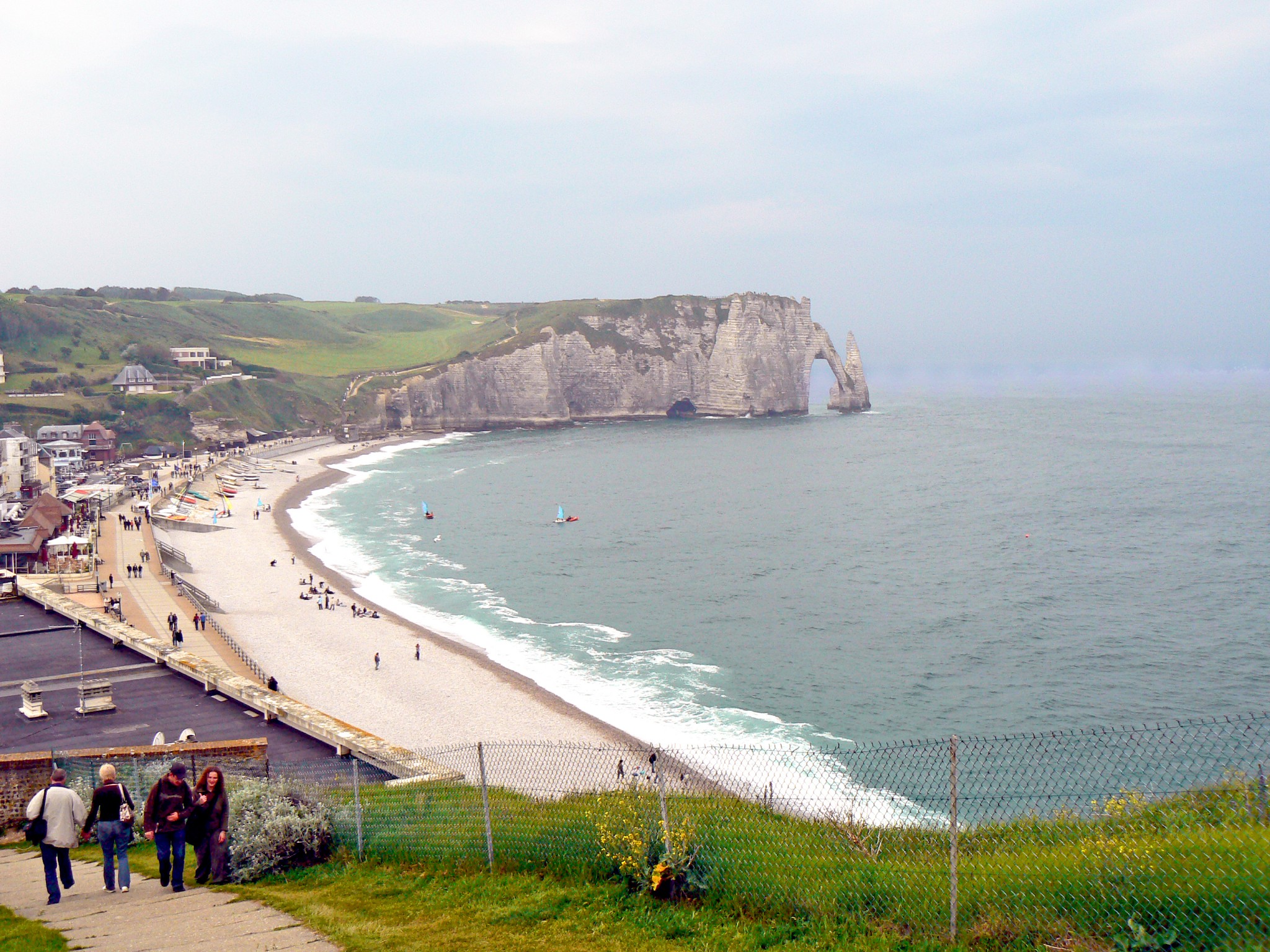
Once standing on the beach, the cliff formations are visible on each side: the Falaise d’Aval to the left and the Falaise d’Amont to the right.
As it is surrounded by cliffs, the little beach is relatively protected from the winds.
Many tourists come here in summer to admire the magnificent setting of Étretat, contributing to its festive atmosphere.
Taking the shingle from the beach is forbidden as it serves as a protection from erosion by the sea.
The beach is separated from the village by a long promenade, named “le Perrey” after a local dialect word meaning “in stoned” (empierré). A “Perrey” used to be the place where boats ran aground.
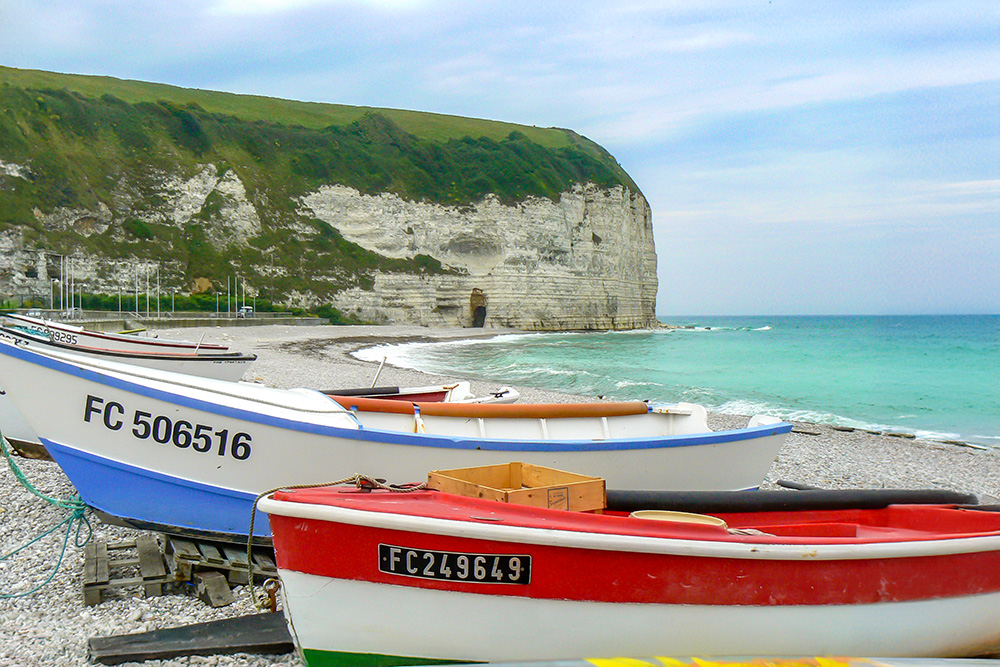
Today, the sea wall serves as a protection for the town from violent storms, particularly during the large tides of equinoxes.
The little town’s origins as a fishing village are still evident with capstans and fishermen’s huts on the seafront, next to the beach.
To enjoy a visit to the small but popular beach and the surrounding cliffs, it is essential to know the high and low tide timetables. Otherwise, the rising tide may trap you between two cliffs!
The Cliffs
The outstanding 70 metre-high white cliffs of Étretat are world-famous and are classified as a national site, with its three rock formations, known as:
- Porte d’Amont (the upstream cliff) – a large rock that juts into the sea,
- Porte d’Aval (the downstream cliff) – arguably the most impressive cliff with its arch and needle, and
- Manneporte – featuring a second natural rock arch above the sea.
![Aiguille and Porte d´Aval - By Jörg Braukmann — licence [CC BY-SA 4.0] from Wikimedia Commons](https://frenchmoments.eu/wp-content/uploads/2012/11/Aiguille-and-Porte-d´Aval-By-Jorg-Braukmann-—-licence-CC-BY-SA-4.0-from-Wikimedia-Commons.jpg)
The Falaise d’Aval
The Falaise d’Aval is reached by a set of stairs (180 steps) leading up to the crumbling (and windy!) side of the cliff.
The path starts at the right end of the beach, where you can see remains of bunkers, part of the “Atlantic Wall”. This was an extensive system built by the Germans to defend against an anticipated Allied invasion of continental Europe from Great Britain.
The local flora has adapted to the cold and violent winds hitting the coast, which dry out the soil. This explains why the plants are smaller in size and why trees are absent.
From the top, the view reaches as far as Le Havre.
But the eye is drawn to the abrupt cliff and the notorious arch, which looks like an elephant dipping its trunk into the sea.
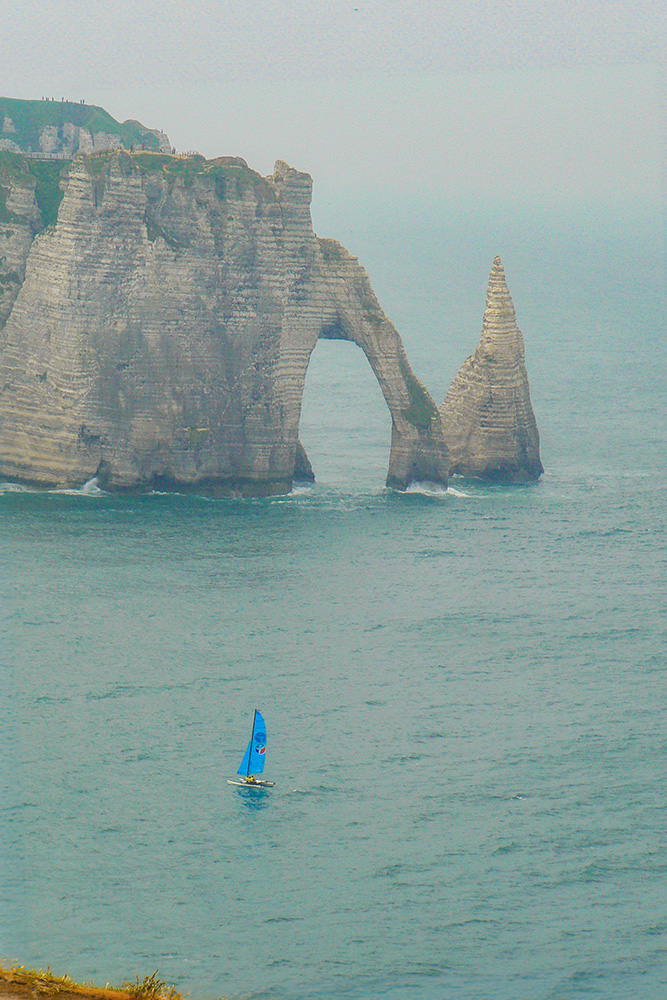
The Hollow Needle
Standing next to it is the “Hollow Needle” (L’Aiguille Creuse), made famous by Maurice Leblanc.
The French novelist, a contemporary of Conan Doyle, created the character of Arsène Lupin, the Gentleman Thief, and set his legendary refuge inside the Needle.
Leblanc is not the only artist who found inspiration in Étretat. Monet, Boudin, Maupassant, and Flaubert were also impressed by the grandeur of this part of Normandy.
Several Monet paintings were painted in and around Etretat.
The Falaise d’Amont
To reach the top of the Falaise d’Aval, a very steep stair path winds up to the top of the “Falaise d’Amont.” (A return walk will take approximately 1 hour.)
Here stands the Notre Dame de la Garde Chapel, made of stone.
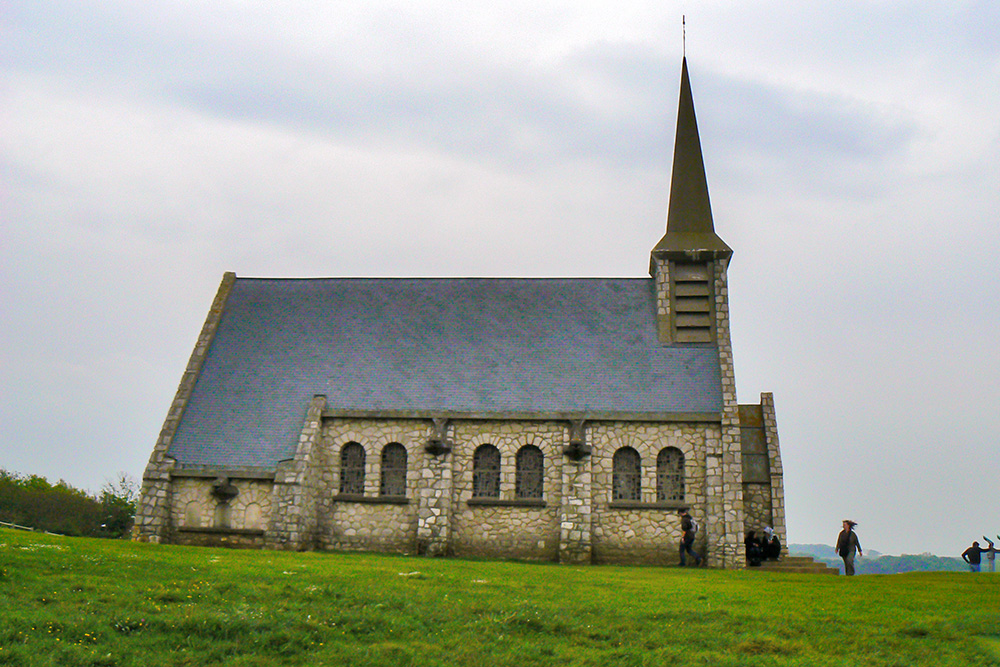
In 1854, Étretat’s fishermen decided to build a chapel dedicated to the Holy Virgin, their Patron Saint.
The Nazis blew out the building in 1942 and it was rebuilt in the early 1950s.
Behind the Chapel stands another monument, which looks like a tall white arrow, dedicated to aviators Nungesser and Coli, who were the first to attempt the crossing of the Atlantic Ocean without stopping.
They departed on the 8th of May 1927 but were never seen since.
Along your walk on Étretat’s cliffs, many birds can easily be observed at a close distance: Common Gulls of course, but also Herring Gulls, Arctic Fulmars, Peregrine Falcons and Cormorants.
The view from the top is outstanding for it embraces the bay of Étretat and the Falaise d’Aval with the Hollow Needle.

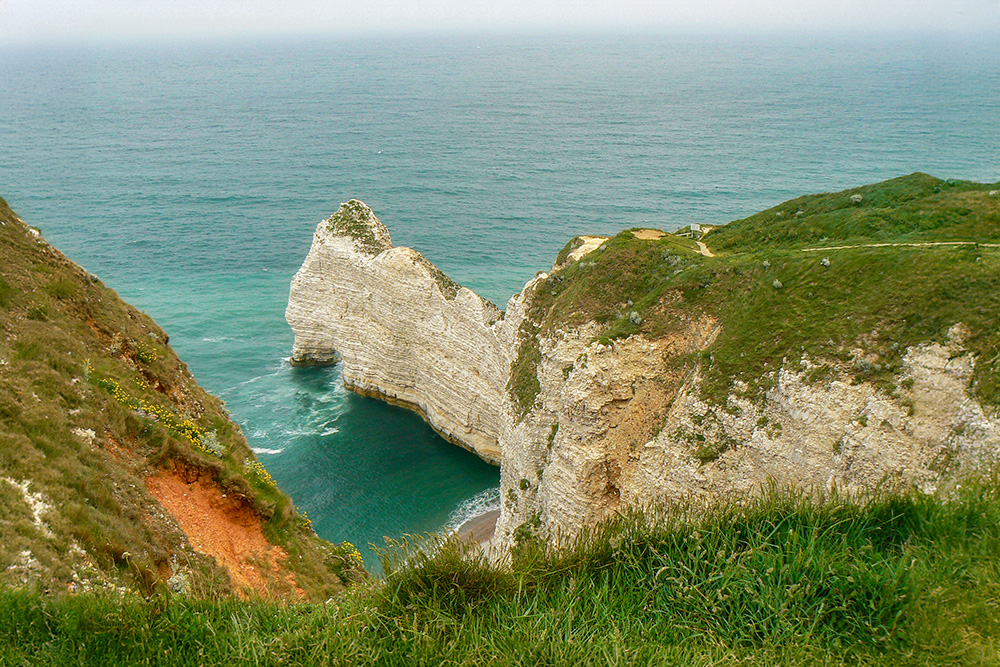
Manneporte
Manneporte, derived from Old French meaning “great door” or “main door,” is a large natural arch located about 500 metres southwest of the Porte d’Aval.
Significantly larger than the Porte d’Aval, Manneporte is so vast that, according to Maupassant, a ship could sail through this Gothic archway with its sails fully unfurled.
The Town Centre
In the town centre of Étretat, there are many interesting half-timbered houses and an old market hall on Place Foch, recently restored to its original wooden beauty.
Nowadays, it is not really used as a traditional French market as it houses tourist boutiques.
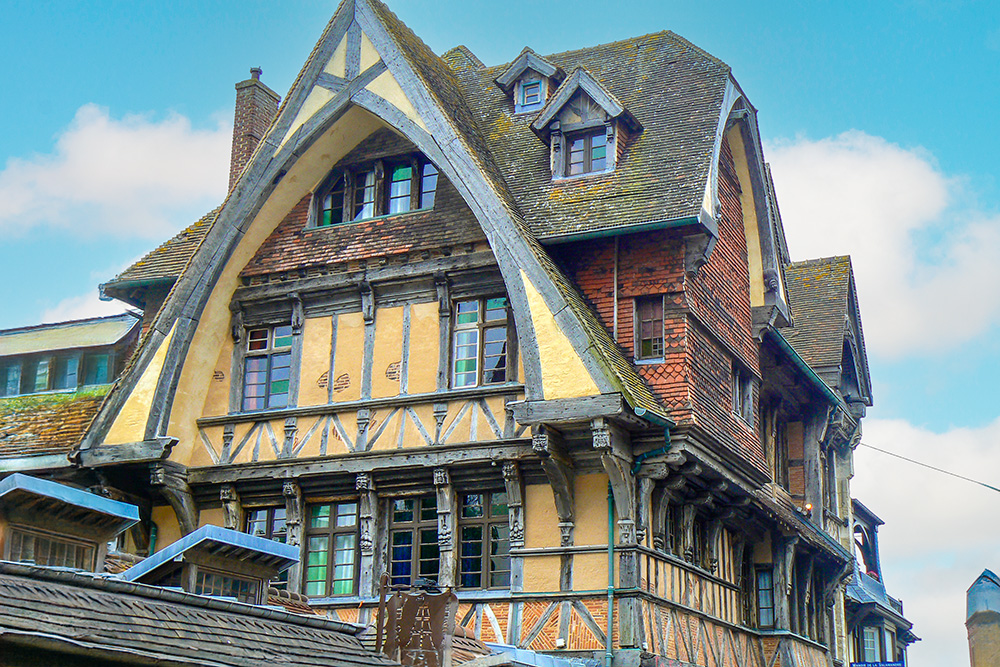
Opposite the market hall, on Boulevard René Coty stands the famous half-timbered house, the “Manoir de la Salamandre”, now a hotel-restaurant.
To see many of Étretat’s old houses, walk down the main street, Boulevard du Président René Coty, which leads to the seafront.
As for Étretat’s restaurants, it will be no surprise to find a fine selection of seafood and fish here, without forgetting the local moules-frites and crêpes.
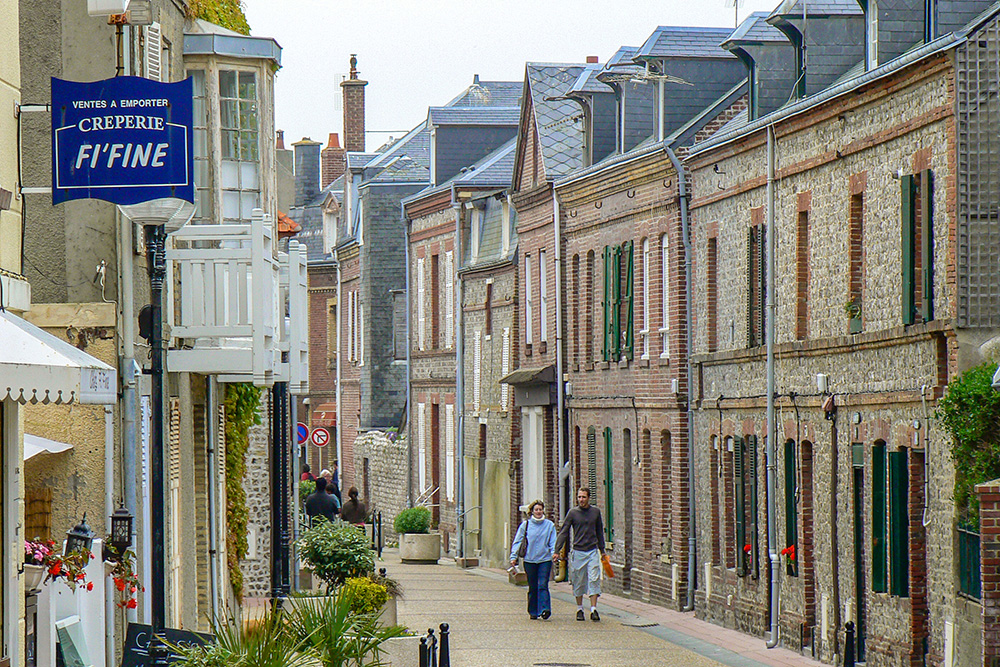
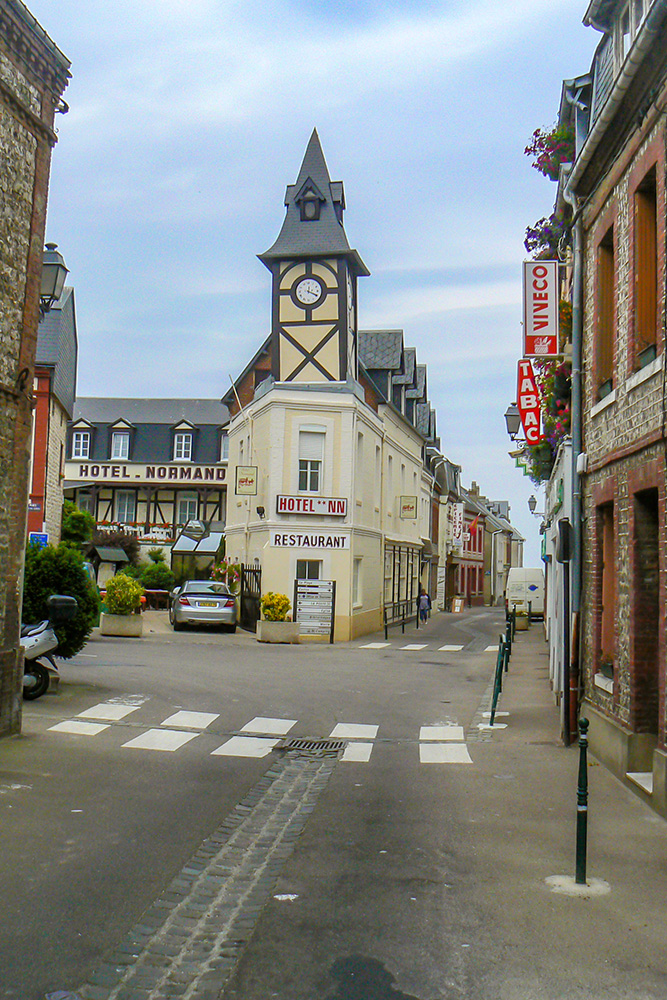
Notre-Dame d’Étretat Church
Notre-Dame d’Étretat Church is located on the outskirts of the village centre, along Avenue Nungesser and Coli.
![Étretat Church - By Gordito1869 — licence [CC BY 3.0] from Wikimedia Commons](https://frenchmoments.eu/wp-content/uploads/2012/11/Etretat-Church-By-Gordito1869-—-licence-CC-BY-3.0-from-Wikimedia-Commons.jpg)
Despite the village’s modest size in the past, this grand edifice reflects its historical dependence on the powerful Abbey of Fécamp.
The church’s construction dates back to the 12th and 13th centuries and was remodelled in the 19th century. It is now classified as a historical monument.
The facade (excluding the 19th-century tympanum) and the first six bays of the nave are in Romanesque style.
The rest of the church, including the choir and aisles, was completed later in the Gothic style during the late 12th and early 13th centuries, with the transept added in the mid-13th century.
Notre-Dame d’Étretat also features in a short story by Maupassant titled “Conflits pour rire,” part of his collection “Contes et nouvelles.”
The Market Halls
The market halls of Étretat (les Halles) are a reconstruction of traditional wooden halls, partly made with reclaimed materials, some sourced from a barn in Brionne.
![Halles Etretat - By Olaf Meister — licence [CC BY-SA 4.0] from Wikimedia Commons](https://frenchmoments.eu/wp-content/uploads/2012/11/Halles-Etretat-By-Olaf-Meister-—-licence-CC-BY-SA-4.0-from-Wikimedia-Commons.jpg)
Designed by architect Emile Mauge in 1926 and built by carpenters from the Manche département, they now house merchants and artisans selling souvenirs and various goods.
Remarkable Castles, Manors, and Villas in Étretat
![Maison Maurice Leblanc - By Gordito1869 — licence [CC BY-SA 4.0] from Wikimedia Commons](https://frenchmoments.eu/wp-content/uploads/2012/11/Maison-Maurice-Leblanc-By-Gordito1869-—-licence-CC-BY-SA-4.0-from-Wikimedia-Commons.jpg)
Étretat is home to several notable castles, manors, and villas:
Château des Aygues: Listed as a historic monument since 1997, this château served as the seaside residence for Queens Maria Christina and Isabella II of Spain. Previously owned by Prince Joseph Lubomirski, Grand Chamberlain to Tsar Nicholas I of Russia, it was constructed in the 19th century based on designs by the Le Havre architect Théodore Huchon.
Villa La Guillette: Constructed upon Guy de Maupassant’s request, this villa has been listed as a historic monument since 2016.
Clos Lupin: Located on Rue Guy de Maupassant, near Maupassant’s former residence “La Guillette,” this half-timbered house is where Maurice Leblanc wrote 19 novels and 39 short stories.
Étretat Protestant Temple: Built in 1883 on Rue Guy de Maupassant, this temple is notable for being the site where André Gide was married.
Manoir de la Salamandre: An admired tourist attraction on the main street near the market hall, but on the opposite side. It is one of the oldest buildings in Étretat, reassembled in the 20th century based on plans by Émile Mauge. Originally located in Lisieux at 50 Grande Rue, it was dismantled in 1889 and reconstructed in Étretat with some modifications. The name “Manoir de la Salamandre” originally referred to a different manor in Lisieux, now gone, with only a few sculptures imitated from it. The interior and exterior carvings were done by sculptor and cabinetmaker Rabot.
![Manoir de la Salamandre - By I, Avvincent - licence [CC BY 3.0] from Wikimedia Commons](https://frenchmoments.eu/wp-content/uploads/2012/11/Maison-de-la-Salamandre-By-I-Avvincent-licence-CC-BY-3.0-from-Wikimedia-Commons.jpg)
Villa Orphée: Overlooking Étretat Bay with a view of the Aval cliff, this villa was built for Jacques Offenbach in 1858, following the success of his opera “Orpheus in the Underworld.” Offenbach hosted numerous receptions here and stayed frequently until his death on 5 October 1880.
Les Jardins d’Étretat
The Jardins d’Etretat, perched on the Amont Cliff are a stunning example of neo-futuristic design featuring “living sculptures.”
Originally surrounding a villa owned by Parisian actress Madame Thébault in the early 20th century, the gardens were restored and reopened to the public in 2017 by a team led by Russian landscape architect Alexander Grivko of the British landscape design firm IL Nature.
Inspired by the flora of the Normandy coast, Grivko’s work earned the 2019/2020 European Garden Award for “Best Restoration or Development of a Historic Park or Garden.”
These gardens are recognised as a “Remarkable Garden” and are listed among the “great gardens of the world”.
![Jardins d'Etretat - By Burnbabyburn — licence [CC BY-SA 4.0] from Wikimedia Commons](https://frenchmoments.eu/wp-content/uploads/2012/11/Jardins-dEtretat-By-Burnbabyburn-—-licence-CC-BY-SA-4.0-from-Wikimedia-Commons.jpg)
In 1905, Madame Thébault acquired a Belle Époque house, “Villa Roxelane,” named after the legendary wife of Sultan Suleiman the Magnificent, a role that had brought Thébault fame.
She enlisted local landscaper Auguste Lecanu to design the garden, planting trees that have now stood for over a century.
Madame Thébault was a friend of French painter Claude Monet, who often visited to paint.
Monet’s inspiration from the Étretat cliffs led to his “Cliffs at Étretat” series and influenced Thébault to create an avant-garde garden atop the cliff.
A vine sculpture in the garden pays tribute to Monet, depicting him working on “Sunset at Étretat.”
The restoration, starting in 2015, meticulously recreated many historical elements of the garden.
Alexander Grivko and his team used techniques inspired by André Le Nôtre, the royal gardener of Versailles.
The extensive project involved acquiring additional land, building walls, importing soil, creating gravel paths, and planting over 30,000 conifers.
👉 Get your ticket here to visit the Jardins d’Etretat!
How to get to Etretat
Étretat is not reached by a motorway, but its closeness to Normandy’s largest cities such as Le Havre (19km) and Rouen (90km) makes it easily accessible by car from Paris (219km), Calais and Caen.
From Paris, take the A13 and A131 motorways in the direction of Le Havre. From there, follow the single carriage-way route départementale 79 which runs through the Côte d’Albatre.
If you are travelling from America or Australia, you can either take a flight to Paris Charles de Gaulle Airport and rent a car there or fly to London.
Ferries cross the Channel regularly from Portsmouth to Le Havre and from Newhaven to Dieppe.
Visit the Tourist information centre of Etretat for more information.




Such an interesting article, Pierre. I had heard of Etretat, but I didn't know anything about it. As usual, your article was a perfect combination of history, current information and beautiful photos. Merci!
Thank you Ellen, Etretat is definitely worth a visit when staying in Normandy near Rouen!